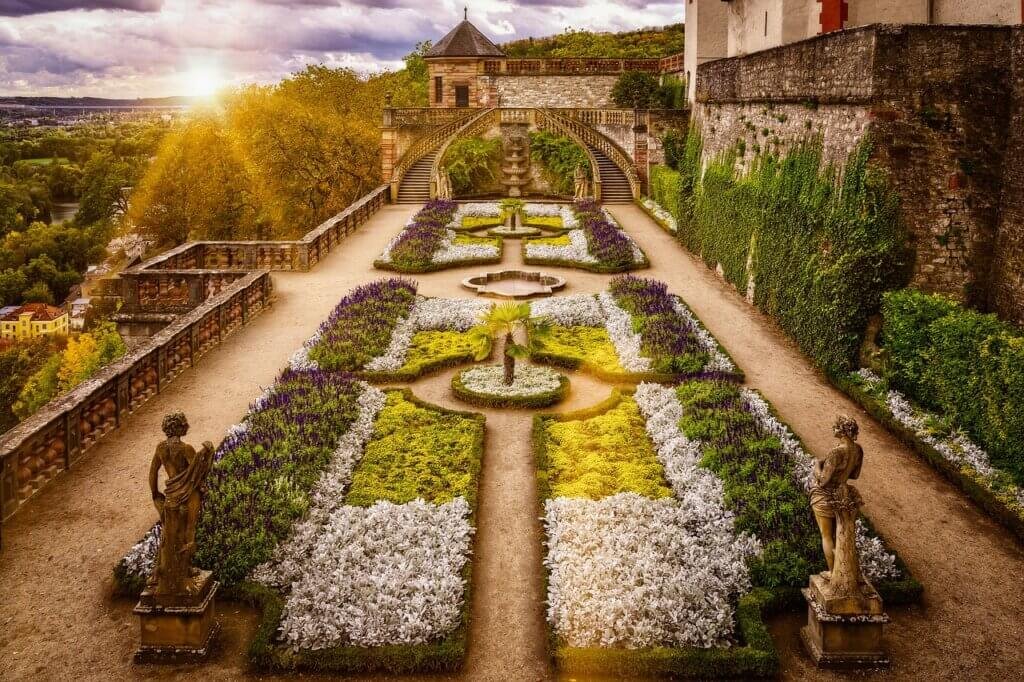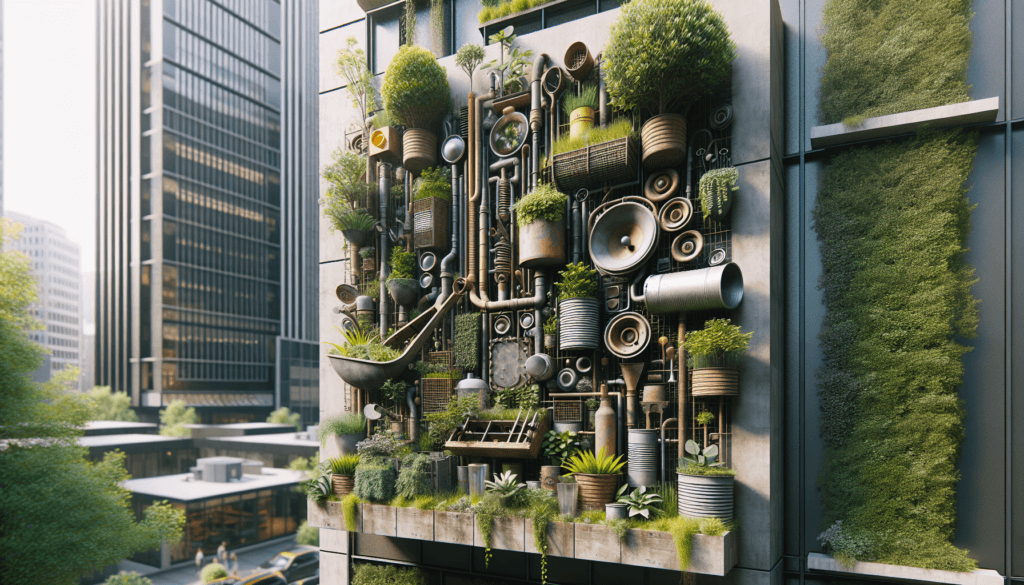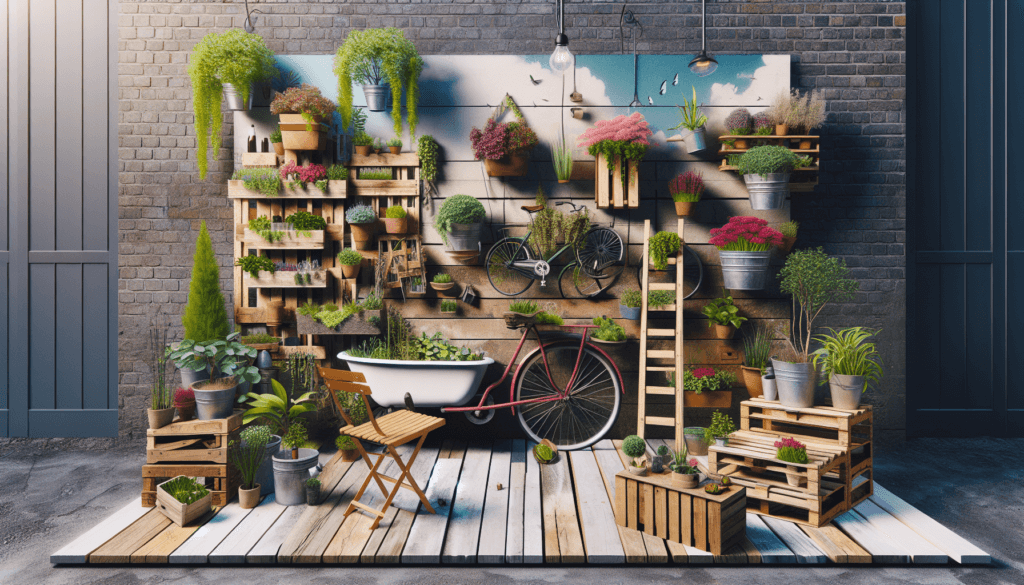Have you ever wondered how to make your urban garden more sustainable while adding a touch of creativity? Look no further! In this article, we will explore some innovative ideas on how to recycle and repurpose objects in your urban garden design, transforming wasted items into functional and aesthetic features. Discover how old pallets can become stylish planters, glass bottles can be transformed into eye-catching wind chimes, and even how old tires can be repurposed to create unique seating areas. With these inspiring ideas, you can create a beautiful, eco-friendly oasis right at your doorstep. So grab your gardening gloves and let’s get started!
I. Reusing Containers
A. Plastic bottles
Plastic bottles can be repurposed into various containers for your urban garden. You can cut off the top portion of a plastic bottle and use it as a mini planter for small plants such as herbs or succulents. Simply fill it with soil, add some seeds or plants, and watch them grow. You can also create hanging planters by cutting holes in the sides of the bottles and attaching strings or wires to hang them from fences or walls. Plastic bottles can also be used as irrigation systems by poking small holes in the bottom and burying them near the roots of your plants.
B. Old buckets and pots
If you have old buckets or pots lying around, don’t throw them away! These can be excellent containers for your urban garden. You can use them for container gardening, planting vegetables, herbs, or even flowers. Their deep bases provide enough space for healthy root growth. Moreover, you can easily move them around to follow the sunlight or change the garden’s layout. Remember to drill holes in the bottom for proper drainage. You can also give your old buckets and pots a makeover by painting them with bright colors or fun designs to add a whimsical touch to your garden.
C. Broken wheelbarrows
Instead of throwing away a broken wheelbarrow, why not repurpose it as a unique and eye-catching planter in your urban garden? With its large size and depth, a broken wheelbarrow can accommodate a variety of plants, creating a stunning focal point. You can fill it with soil, add your favorite plants or herbs, and even incorporate a trellis for climbing vines. The wheelbarrow’s handles can also be repurposed as hooks for hanging gardening tools or decorative items. This creative use of a broken wheelbarrow adds character and charm to your garden while reducing waste.
II. Upcycling Materials
A. Wooden pallets
Wooden pallets are versatile materials that can be upcycled into various garden structures. You can transform them into raised bed planters by stacking them and filling them with soil. Not only does this provide a convenient gardening space, but it also adds an interesting design element to your urban garden. Wooden pallets can also be used to create vertical gardens by attaching pots or containers to the slats. This maximizes space and allows for more plants in a small area.
B. Metal scraps
If you have metal scraps lying around, don’t let them go to waste! They can be upcycled to create unique garden features. For example, you can repurpose old metal gates or fences as trellises for climbing plants, such as tomatoes or beans. Metal scraps can also be transformed into garden art, such as sculptures or decorative stakes. By repurposing these materials, you not only reduce waste but also add a touch of creativity and character to your urban garden.
C. Tires and rubber
Tires and rubber products can serve multiple purposes in an urban garden. You can transform old tires into planters by filling them with soil and using them to grow flowers, herbs, or vegetables. Stack the tires on top of each other to create a visually appealing tower of plants. Additionally, cut tires can be used as borders for garden beds or walkways, giving your garden a distinctive and eco-friendly look. If you have rubber mats or flooring scraps, they can also be repurposed as mulch or ground cover, preventing weed growth and retaining moisture in the soil.

III. Repurposing Furniture
A. Old chairs and benches
Instead of discarding old chairs and benches, consider giving them a new life in your urban garden. You can repurpose them as unique plant holders by removing the seats and placing pots or containers in their place. The backrests of chairs can also be repurposed as trellises or stakes for climbing plants. Old benches can be turned into cozy seating areas by adding cushions or pillows and placing them in a shaded corner of your garden. Repurposing furniture not only reduces waste but also adds a touch of charm and nostalgia to your urban garden.
B. Dressers and cabinets
Old dressers and cabinets can be repurposed as functional and stylish storage in your urban garden. You can transform them into vertical planters by removing the drawers and replacing them with pots or containers. This not only maximizes vertical space but also adds a unique and artistic element to your garden. The drawers can be repurposed as storage units for gardening tools or as shelves for displaying potted plants. With a coat of paint or some decorative accents, old dressers and cabinets can become beautiful focal points in your urban garden.
C. Bookshelves and shelves
Unused bookshelves or shelves can be repurposed in your urban garden to provide storage and display space for your plants and gardening essentials. You can place pots or containers on the shelves to create a vertical garden, making the most of limited space. Bookshelves can also be transformed into plant stands by removing some shelves or creating staggered platforms to showcase different plant sizes and varieties. By repurposing these furniture pieces, you not only add functionality to your garden but also create an aesthetically pleasing and organized space.
IV. Recycling Green Waste
A. Composting
Composting is an excellent way to recycle green waste and create nutrient-rich soil for your urban garden. Start by collecting kitchen scraps such as vegetable and fruit peels, coffee grounds, and eggshells. Mix them with yard waste like grass clippings, leaves, and small branches. Layer these materials in a compost bin or pile, making sure to turn it regularly to promote decomposition. Over time, the organic matter will break down, resulting in nutrient-dense compost that can be used to enrich the soil in your garden beds or containers.
B. Mulching
Mulching is another effective way to recycle green waste and enhance your urban garden. Instead of throwing away leaves or grass clippings, use them as mulch to cover the soil around your plants. Mulch helps retain moisture, suppresses weed growth, and regulates soil temperature. It also breaks down over time, enriching the soil with organic matter. Additionally, mulch gives your garden a neat and polished appearance. Just be sure not to use diseased plant material or too thick of a layer, as it may hinder the health of your plants.
C. Vermiculture
Vermiculture, or worm composting, is a sustainable way to recycle green waste while producing high-quality compost for your urban garden. Start by setting up a worm bin, preferably with red wigglers, in a shady and protected spot. Add shredded newspaper, cardboard, or paper products as bedding for the worms. Then, introduce kitchen scraps such as fruit and vegetable peels, coffee grounds, and tea bags. The worms will consume the organic waste and produce nutritious worm castings, also known as vermicompost. This vermicompost can be added to your garden beds or containers to promote healthy plant growth.

V. Innovative Water Reuse
A. Rainwater harvesting
Rainwater harvesting is an eco-friendly method of utilizing water resources in your urban garden. Install rain barrels or cisterns to collect rainwater from your roof or gutters. This water can be used to irrigate your garden during dry spells or periods of water restrictions. It’s important to use a screen or mesh cover to prevent debris and mosquitoes from entering the barrels. With rainwater harvesting, you not only conserve water but also reduce your reliance on municipal water supplies, which may be treated with chemicals.
B. Graywater systems
Graywater, which refers to wastewater from sources such as sinks, showers, and washing machines, can be reused to water plants in your urban garden. Set up a graywater system to capture and divert water from these sources to your garden. Install a separate plumbing system that directs graywater to an outdoor reservoir or directly to irrigation lines. However, it’s crucial to use eco-friendly and biodegradable soaps and detergents to avoid harming your plants or the environment. Graywater systems are a sustainable way to reduce water waste and keep your garden thriving.
C. Vertical aquaponics
Vertical aquaponics combines the principles of aquaculture and hydroponics to create a self-sustaining and innovative water reuse system for your urban garden. In this system, fish are raised in a tank, and their waste is converted into nutrients for plants. The nutrient-rich water is then circulated to the plant beds, where plants grow hydroponically without soil. The plants filter the water, which is then returned to the fish tank. Vertical aquaponics maximizes space by stacking plant beds vertically, making it ideal for small urban gardens. It’s a fascinating and efficient way to grow both food and ornamental plants while minimizing water usage.
VI. Creating Art Installations
A. Mosaic pathways
Mosaic pathways add a touch of artistry and whimsy to your urban garden. Instead of using traditional paving materials, such as concrete or stone, you can repurpose broken tiles, ceramics, or glass to create colorful mosaic designs. Lay the mosaic pieces in patterns or create unique designs that reflect your personal style. This creative use of recycled materials not only reduces waste but also transforms your garden into a vibrant and visually stunning space. Mosaic pathways can be used to delineate different garden sections, lead to seating areas, or simply add a decorative element to your garden.
B. Sculptures and structures
Repurposing old materials to create sculptures and structures in your urban garden adds a unique and artistic touch to the space. You can use metal scraps, driftwood, or discarded items to construct sculptures that reflect your creativity and personality. Consider creating sculptures of animals, abstract shapes, or even human figures. These sculptures can be placed strategically throughout your garden to create focal points or conversation starters. Additionally, repurposed materials can be used to build structures such as arbors, pergolas, or archways, adding architectural interest and providing support for climbing plants.
C. Vertical garden art
Vertical garden art combines the beauty of plants with creative design to produce visually stunning installations in your urban garden. Instead of using traditional planters or containers, repurpose items such as pallets, old frames, or mesh panels to create vertical structures. Attach pots or containers to the surfaces and fill them with vibrant plants or colorful flowers. Arrange the structures in visually appealing patterns or create unique shapes that complement your garden’s overall design. Vertical garden art not only maximizes space but also adds an artistic and natural element that transforms your urban garden into a living work of art.

VII. Incorporating Sustainable Lighting
A. Solar-powered lights
Solar-powered lights are an eco-friendly and cost-effective way to illuminate your urban garden. These lights harness the power of the sun during the day and store it in rechargeable batteries. They automatically turn on at dusk to provide ambient lighting throughout the night. Solar-powered lights come in various styles, including string lights, pathway lights, or even decorative lanterns. By incorporating solar-powered lights into your garden design, you not only reduce electricity consumption but also create a magical and inviting atmosphere for evening gatherings or quiet moments of relaxation.
B. Bottle lanterns
Bottle lanterns are a creative and sustainable way to add a touch of whimsy to your urban garden. Repurpose empty glass bottles by inserting solar-powered LED string lights into them. The string lights will illuminate the bottles at night, creating a beautiful and ethereal glow. You can hang the bottle lanterns from tree branches, fences, or pergolas to add ambient lighting to your garden. Additionally, consider using bottles of different colors to create a mesmerizing display of light and color. Bottle lanterns are not only environmentally friendly but also a fun DIY project that adds personality to your urban garden.
C. Upcycled chandeliers
Upcycled chandeliers are a unique and eye-catching way to incorporate sustainable lighting into your urban garden. Instead of traditional chandeliers, repurpose old fixtures or items such as old metal baskets, bicycle wheels, or even wine barrels. Add LED candles or solar-powered lights to these upcycled elements, creating a stunning focal point that illuminates your garden at night. Hang the upcycled chandeliers from trees, pergolas, or trellises to create a magical and whimsical atmosphere. This creative approach to garden lighting not only reduces waste but also adds a touch of elegance and charm to your urban oasis.
VIII. Building Vertical Gardens
A. Hanging planters
Hanging planters are an excellent way to maximize vertical space in your urban garden. Use repurposed materials such as plastic bottles, old containers, or even shoes to create unique hanging planters. You can attach strings, ropes, or chains to these containers and hang them from fences, walls, or pergolas. Fill the hanging planters with your favorite flowers, herbs, or trailing plants to create a beautiful vertical display. Hanging planters not only add visual interest to your garden but also free up valuable ground space, allowing you to grow more plants in a limited area.
B. Living walls
Living walls, also known as green walls or vertical gardens, are a stunning way to incorporate plants into your urban garden design. These walls are covered with vegetation, providing not only aesthetic appeal but also environmental benefits such as improved air quality and thermal regulation. You can create a living wall by attaching modular planting units or pockets to a vertical surface. Fill the pockets with a variety of plants, including flowers, herbs, or even small vegetables. Living walls can be freestanding structures, attached to fences or walls, or even integrated into existing architecture to create a vibrant and lush display of greenery.
C. Trellises and arbors
Trellises and arbors are essential elements for vertical gardening in an urban setting. Repurpose old materials such as wooden pallets, metal rods, or discarded ladders to create unique trellises or arbors. These structures provide support for climbing plants such as tomatoes, beans, or peas, creating a vertical focal point in your garden. You can also enhance the beauty of trellises and arbors by incorporating trailing vines or colorful flowers. Additionally, trellises and arbors can act as natural dividers, creating separate garden spaces or providing shade and privacy. Building vertical gardens with trellises and arbors not only maximizes space but also adds structure and dimension to your urban garden.

IX. Implementing Companion Planting
A. Guild planting
Guild planting is a sustainable and efficient method of companion planting in your urban garden. It involves grouping together plants that have a mutually beneficial relationship, promoting healthy growth and pest management. For example, you can create a guild by planting a fruit tree as the centerpiece and surrounding it with plants such as herbs, flowers, or vegetables that help repel pests, improve soil fertility, or provide nitrogen fixation. The combination of plants in a guild provides natural pest control, attracts pollinators, and optimizes space utilization in your urban garden.
B. Three Sisters planting
Three Sisters planting is an ancient Native American gardening technique that combines corn, beans, and squash in a symbiotic relationship. The corn provides a structure for the beans to climb, and the beans fix nitrogen in the soil, benefiting the corn and squash. The squash acts as a living mulch, suppressing weed growth and conserving moisture. Together, these three crops support and complement each other, maximizing space and crop yield. Implementing Three Sisters planting in your urban garden not only provides a sustainable and space-efficient gardening method but also honors traditional agricultural practices.
C. Trap cropping
Trap cropping is a strategy that involves planting specific plants to lure pests away from your main crops. By using decoy crops that pests find more attractive, you can protect your desired plants and reduce the need for chemical pesticides. For example, if aphids are a problem in your urban garden, plant a trap crop of nasturtiums to attract them. The nasturtiums will act as a sacrificial crop, drawing the aphids away from your other plants. By implementing trap cropping, you create a more balanced and eco-friendly environment in your urban garden, promoting natural pest control and preserving the health of your crops.
X. Engaging in Seed Saving
A. Collecting and storing seeds
Seed saving is a time-honored practice that allows you to preserve and propagate plant varieties in your urban garden. Start by selecting healthy and mature seeds from your strongest and most productive plants. Allow the seeds to fully dry before collecting and storing them in a cool, dry place. Label the seeds with the plant variety and the year they were collected. Storing seeds properly ensures their viability for future planting seasons, allowing you to continue growing your favorite plant varieties and preserving biodiversity in your urban garden.
B. Creating a seed library
A seed library is a community resource that allows gardeners to borrow and exchange seeds. By participating in a seed library, you not only have access to a diverse range of plant varieties but also contribute to the preservation and sharing of seeds. Consider starting a seed library in your urban garden or joining an existing one in your community. This collaborative effort fosters a sense of community, promotes sustainable gardening practices, and ensures the availability of heirloom and open-pollinated seeds for future generations.
C. Participating in seed swaps
Seed swaps are events where gardeners gather to exchange seeds, share knowledge, and build connections within the gardening community. Participating in seed swaps allows you to diversify your urban garden’s plant varieties, discover new plants, and learn from experienced gardeners. Bring your saved seeds to swap with others, and explore the wide array of seeds available from fellow gardeners. Seed swaps are not only an opportunity to grow exciting and unique plants but also a chance to engage in sustainable gardening practices and connect with like-minded individuals who share a passion for urban gardening.



